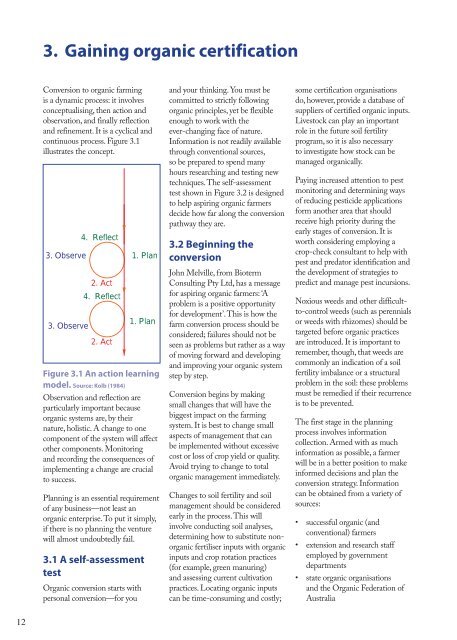4. Organic vegetable production
4. Organic vegetable production
4. Organic vegetable production
Create successful ePaper yourself
Turn your PDF publications into a flip-book with our unique Google optimized e-Paper software.
3. Gaining organic certification<br />
Conversion to organic farming<br />
is a dynamic process: it involves<br />
conceptualising, then action and<br />
observation, and finally reflection<br />
and refinement. It is a cyclical and<br />
continuous process. Figure 3.1<br />
illustrates the concept.<br />
3. Observe<br />
3. Observe<br />
<strong>4.</strong> Reflect<br />
2. Act<br />
<strong>4.</strong> Reflect<br />
2. Act<br />
1. Plan<br />
1. Plan<br />
Figure 3.1 An action learning<br />
model. Source: Kolb (1984)<br />
Observation and reflection are<br />
particularly important because<br />
organic systems are, by their<br />
nature, holistic. A change to one<br />
component of the system will affect<br />
other components. Monitoring<br />
and recording the consequences of<br />
implementing a change are crucial<br />
to success.<br />
Planning is an essential requirement<br />
of any business—not least an<br />
organic enterprise. To put it simply,<br />
if there is no planning the venture<br />
will almost undoubtedly fail.<br />
3.1 A self-assessment<br />
test<br />
<strong>Organic</strong> conversion starts with<br />
personal conversion—for you<br />
and your thinking. You must be<br />
committed to strictly following<br />
organic principles, yet be flexible<br />
enough to work with the<br />
ever-changing face of nature.<br />
Information is not readily available<br />
through conventional sources,<br />
so be prepared to spend many<br />
hours researching and testing new<br />
techniques. The self-assessment<br />
test shown in Figure 3.2 is designed<br />
to help aspiring organic farmers<br />
decide how far along the conversion<br />
pathway they are.<br />
3.2 Beginning the<br />
conversion<br />
John Melville, from Bioterm<br />
Consulting Pty Ltd, has a message<br />
for aspiring organic farmers: ‘A<br />
problem is a positive opportunity<br />
for development’. This is how the<br />
farm conversion process should be<br />
considered; failures should not be<br />
seen as problems but rather as a way<br />
of moving forward and developing<br />
and improving your organic system<br />
step by step.<br />
Conversion begins by making<br />
small changes that will have the<br />
biggest impact on the farming<br />
system. It is best to change small<br />
aspects of management that can<br />
be implemented without excessive<br />
cost or loss of crop yield or quality.<br />
Avoid trying to change to total<br />
organic management immediately.<br />
Changes to soil fertility and soil<br />
management should be considered<br />
early in the process. This will<br />
involve conducting soil analyses,<br />
determining how to substitute nonorganic<br />
fertiliser inputs with organic<br />
inputs and crop rotation practices<br />
(for example, green manuring)<br />
and assessing current cultivation<br />
practices. Locating organic inputs<br />
can be time-consuming and costly;<br />
some certification organisations<br />
do, however, provide a database of<br />
suppliers of certified organic inputs.<br />
Livestock can play an important<br />
role in the future soil fertility<br />
program, so it is also necessary<br />
to investigate how stock can be<br />
managed organically.<br />
Paying increased attention to pest<br />
monitoring and determining ways<br />
of reducing pesticide applications<br />
form another area that should<br />
receive high priority during the<br />
early stages of conversion. It is<br />
worth considering employing a<br />
crop-check consultant to help with<br />
pest and predator identification and<br />
the development of strategies to<br />
predict and manage pest incursions.<br />
Noxious weeds and other difficultto-control<br />
weeds (such as perennials<br />
or weeds with rhizomes) should be<br />
targeted before organic practices<br />
are introduced. It is important to<br />
remember, though, that weeds are<br />
commonly an indication of a soil<br />
fertility imbalance or a structural<br />
problem in the soil: these problems<br />
must be remedied if their recurrence<br />
is to be prevented.<br />
The first stage in the planning<br />
process involves information<br />
collection. Armed with as much<br />
information as possible, a farmer<br />
will be in a better position to make<br />
informed decisions and plan the<br />
conversion strategy. Information<br />
can be obtained from a variety of<br />
sources:<br />
• successful organic (and<br />
conventional) farmers<br />
• extension and research staff<br />
employed by government<br />
departments<br />
• state organic organisations<br />
and the <strong>Organic</strong> Federation of<br />
Australia<br />
12

















